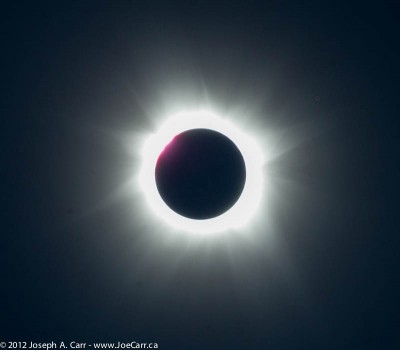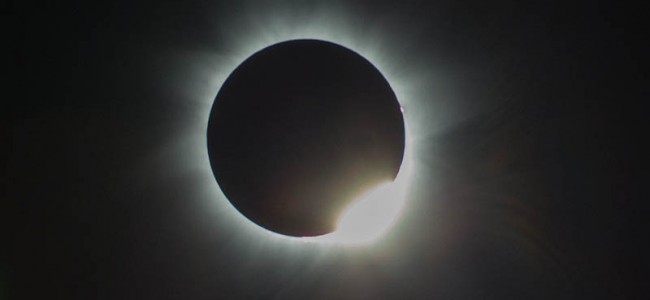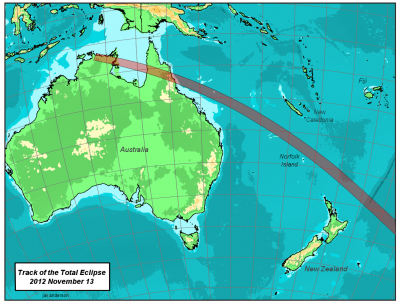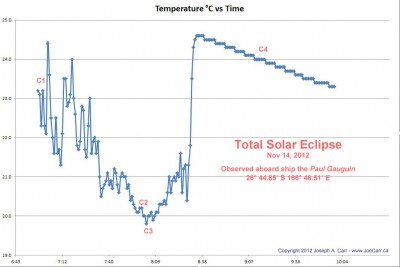November 14, 2012 – Wednesday – Total Solar Eclipse of the Sun – observed from aboard the Paul Gauguin cruise ship sailing about 200km south of New Caledonia in the Coral Sea
2012 Total Solar Eclipse cruise
I am up at 5:30AM, beating my alarm by a few minutes. Skipping breakfast, I gather my eclipse gear and setup on the Pool Deck. I mount my Kestrel 4500 portable weather station on a nearby towel deposit box, and also mount my little Fuji point-and-shoot camera on the same box to take some HD video during Totality (and a minute before and after).
My observing log entry for the eclipse:
Date/Time – local ship’s time
Start: Nov 14, 2012 6:49AM
Finish: Nov 14, 2012 8:12AMLocation: On the totality track 200km south of New Caledonia in the Coral sea, South Pacific. Position: 26° 40′ 0″ S 166° 46′ 54″ E
Observers: 320 passengers (plus crew) on board the Paul Gauguin cruise ship
I observe a total solar eclipse from the pool deck of the cruise ship Paul Gauguin, as part of a TravelQuest tour group. Rick Fienberg and Bill Kramer, in cooperation with Captain Ante-Toni Mirkovic decide to turn the ship 180° just before 1st Contact in order to avoid a large cloud which is starting to obscure the view of the Sun. This proves to be a good move, since we are now slowly sailing away from the clouds in the area, and yet continue to stay within the maximum totality centreline track.
- 1st Contact 6:57:20AM Alt=26º
- 2nd Contact 8:01:20AM Alt=40º
- Totality lasts 3 minutes, 1 second
- 3rd Contact 8:04:21AM Alt=40º
- 4th Contact 9:16:47AM Alt=57º

A few minutes before 2nd Contact, my portable weather station records the expected sharp drop in temperature (see graph below), and the light levels are greatly reduced. About 10 minutes before 2nd Contact, Venus is visible to the left of the Sun, and then as darkening continues, Saturn also appears equidistant between Venus and the Sun.
A dramatic darkening occurs during totality (2nd Contact to 3rd Contact). During totality, I visually observe spectacular coronal streamers. Although I do not find that Bailey’s Beads are easily observed during this eclipse, I observe a red glow around parts of the perimeter of the Sun and some solar prominences are visible.
There is lots of hooting and hollering as the (second) spectacular diamond ring appears at 3rd Contact. I capture these human reactions to experiencing a total solar eclipse using a point-and-shoot camera in HD video mode.
I stop observing and photographing the eclipse shortly after 3rd Contact, although I continue to take temperature readings to the end.
Everyone has a smile on his or her face after the event is over, and there are lots of stories told afterward at lunch and dinner. Despite it only being 9:30 in the morning, Corona beer and cocktails are served to celebrate our success. I have a celebratory cappuccino, and finally have my breakfast mid-morning at La Palette.
2012 Total Solar Eclipse – Bill Kramer’s Eclipse Chasers website, including his personal report and links to other reports
I take temperature measurements from my position on the Pool Deck before, during and after totality. My readings are measured with a Kestrel 4500 personal weather station, which is mounted about one metre above the ship’s deck.
6:57AM 23.2ºC – 1st Contact
7:20AM 22.0ºC
7:39AM 20.9ºC
7:55AM 20.5ºC
8:01AM 20.2ºC – 2nd Contact
8:04AM 19.8ºC – 3rd Contact
8:12AM 20.3ºC
8:25AM 21.3ºC
9:00AM 24.2ºC
9:16AM 24.0ºC – 4th Contact
12:20PM 20.4ºC
The temperature drop is 3.5ºC, which is much lower than expected. Obviously the mild climate near the ocean’s surface results in less daytime heating, and therefore less temperature range is covered for this eclipse at this location.
I dedicate the temperature measurements I took during this eclipse to the memory of Jim Low, a long time member of the Royal Astronomical Society of Canada, Toronto Centre. If Jim had survived, I’m sure he would have traveled with his fellow Toronto Centre members to Australia, and would have recorded the temperature drop, as he did when I traveled with this group to observe the Total Solar Eclipse (my first) from the Libyan Sahara Desert in 2006.
























